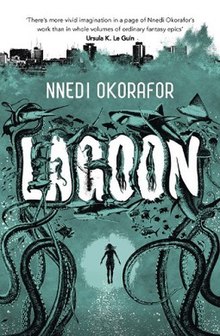Lagoon (novel)
Lagoon is an africanfuturist novel by Nnedi Okorafor (2014, Hodder & Stoughton; 2015, Saga Press/Simon & Schuster). It has drawn much scholarly attention since its publication.[1][2][3][4] In 2014 it was chosen as an honor list title for the James Tiptree Jr. Award.[5]
 First edition | |
| Author | Nnedi Okorafor |
|---|---|
| Cover artist | Joey Hi-Fi |
| Language | English |
| Published | 2014 Hodder and Stoughton |
Summary
According to Hugh Charles O'Connell:
Lagoon develops its ... narrative across three acts: "Welcome" (in which the aliens make contact with the people of Lagos), "Awakening" (an explosion of violence across the city after contact is made), and "Symbiosis" (a period of utopian transformation, in which the aliens and humans come together to form a new postcapitalist Nigeria). Across these three acts, the novel's primary plot revolves around the alien ambassador, Ayodele, and her interactions with three human protagonists: Adaora, a marine biologist; Agu, a Nigerian soldier; and Anthony, a Ghanaian hip-hop artist. Blending its SF topoi with fantasy and folklore elements, we learn that the three human protagonists have special abilities (Adaora can create a shield around herself and breathe underwater, Agu has superhuman strength, and Anthony can make his voice heard and understood at great distances). Alongside these fantastical powers, the novel also incorporates various Nigerian folkloric and mythical entities, which physically manifest themselves and interact with the material world after being awakened by the aliens in the second act. Such figures include Udide Okwanka, a trickster spider and master weaver of tales from Igbo folklore; Legba, the Yoruba trickster god of language and the crossroads who is recast as an expert 419 scammer, but who also shows up in spirit form as Papa Legba; and new figures such as the Bone Collector, a sentient stretch of the Lagos-Benin highway that attacks humans.[6]
References
- Esthie Hugo (2017) Looking forward, looking back: animating magic, modernity and the African city-future in Nnedi Okorafor's Lagoon, Social Dynamics, 43:1, 46-58, doi:10.1080/02533952.2017.1345528.
- Melody Jue, 'Intimate Objectivity: On Nnedi Okorafor's Oceanic Afrofuturism', WSQ: Women's Studies Quarterly, 45.1-2 (Spring/Summer 2017), 171-88, doi:10.1353/wsq.2017.0022.
- O'Connell, Hugh Charles (2016). "'We are change': The Novum as Event in Nnedi Okorafor's Lagoon". Cambridge Journal of Postcolonial Literary Inquiry. 3: 291–312. doi:10.1017/pli.2016.24.
- Michael Paye (2019) Beyond A Capitalist Atlantic: Fish, Fuel, and the Collapse of Cheap Nature in Ireland, Newfoundland, and Nigeria, 'Irish University Review', 49.1, 117-34, doi:10.3366/iur.2019.0384
- Notkin, Debbie. "The 2014 Tiptree Award winner has been selected!". James Tiptree, Jr. Literary Award. Retrieved 1 February 2019.
- O'Connell, Hugh Charles (2016). "'We are change': The Novum as Event in Nnedi Okorafor's Lagoon". Cambridge Journal of Postcolonial Literary Inquiry. 3: 291–312. doi:10.1017/pli.2016.24.